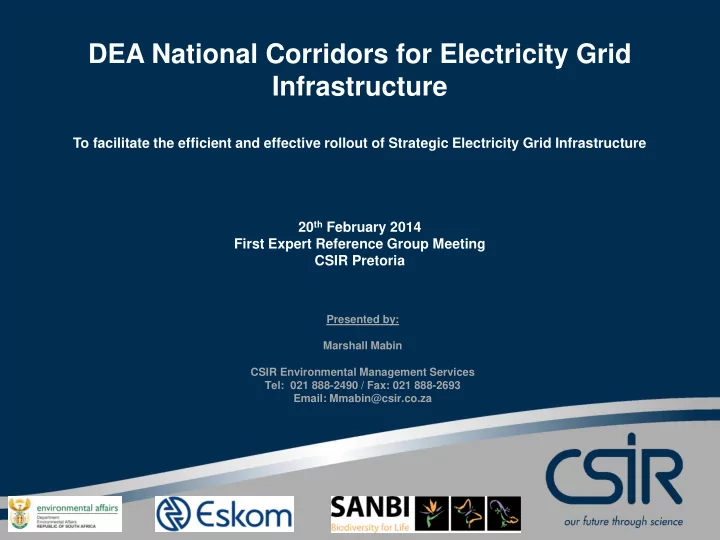

DEA National Corridors for Electricity Grid Infrastructure To facilitate the efficient and effective rollout of Strategic Electricity Grid Infrastructure 20 th February 2014 First Expert Reference Group Meeting CSIR Pretoria Presented by: Marshall Mabin CSIR Environmental Management Services Tel: 021 888-2490 / Fax: 021 888-2693 Email: Mmabin@csir.co.za
Electrical Grid Infrastructure SEA Project Team Project Coordinator: DEA Dee Fischer Surprise Zwane Project Coordinator Project Manager Project Partner: Eskom Ronald Marais Kevin Leask Head of Strategic Transmission Planning Chief Transmission Engineer Environmental Consultants: CSIR Paul Lochner Cornelius van der Westhuizen Marshall Mabin SEA Project Leader SEA Project Liaison EGI SEA Project Manager Joint Service Provider: South African National Biodiversity Institute Jeffrey Manuel
Government Need • National Infrastructure Plan announced in 2012, driven by PICC. • 18 Strategic Integrated Projects Identified • SIP 10 – Electricity transmission and distribution for all • Current Environmental Legislative framework is seen as a constraint to achieving the objectives of the SIP program • DEA reviewing the current authorisation process to support these development requirements
Eskom Need EIA process in current form hampers the efficient and effective expansion of strategic national electrical grid infrastructure. 1. Lengthy timeline for achieving environmental authorisation; 7 years to achieve authorisation 2. EIA does not facilitate strategic planning and investment at a spatial scale EIA is project specific in nature (sections of line) EIA authorisation is valid for 5 years only 3. Output of EIA is inflexible EIA directs grid extension over single parcels of land- high instances of appeal; 4. Multitude of additional authorisations and permits needed from competent authorities Lack of coordination between competent authorities means decision making by authorities is undertaken in isolation. 5. Fails to assess cumulative impacts EIA- sections of line, not national picture
Aim of SEA: Revise the environmental authorisation process for strategic electrical grid infrastructure development to facilitate efficient, effective and responsible expansion in support of SIP10 Effective Responsible Efficient
Objectives of SEA • Effective – Identify strategic corridors for future electrical grid expansion • Efficient – Streamline the authorisation process. – Enable Eskom greater flexibility when undertaking land negotiation. – Enable upfront infrastructure investment. – Promote collaborative governance between authorising authorities. • Responsible – Develop a site specific development protocol and EMPr. – Development of a Bird and Bat database. – Sharing of project information. – Contribute to skills development.
SEA Delivery Process
Identification of Corridors • Eskom has identified strategic routes based on future supply and demand balance scenarios and location of key existing supporting energy infrastructure; • 50km buffer created either side of desired Eskom route • 5 x corridors identified – Central – East Coast – Northern Import – Solar – West Coast • SEA to consider all of the required corridors
Positive and Negative Mapping • Identify and map exclusion (negative) criteria, both from a technical and environmental perspective; • Identify and map development (positive) criteria • Identify and map buffering thresholds • Develop composite map which responds to the above criteria: – Polarise, redirect or pinch the location of the corridors; – Identify exclusion zones and priority development zones within corridors to guide routing options
Corridor Sensitivity Evaluation Specialist sensitivity evaluation will be undertaken within identified corridors • Specialist input to: – Refine corridor boundaries – Refine exclusion mapping within corridors; – Add sensitivity mapping to corridors (no-go, high, medium or low); – Analyse findings from Bird and Bat Database – Draft Development Protocol/EMPr .
Cabinet Approval Process Stakeholder Engagement Ministers SEAs Recommendations Gazetted Corridors Cabinet Approval and Site Specific Protocol and Site Specific Protocol MinMec Consensus Environmental Authorities
Consultation Process • Comprehensive consultation process will be undertaken throughout the duration of the project – Expert Reference Group meetings – Project Steering Committee meetings – Provincial workshops – Sector Specific meetings ((BUSA, CoM, Agric SA, SAPVIA, SAWEA, farmer associations, NGOs) • Consultation will be accomplished through focus group meetings, public meetings as well as an online consultation process
Timeframes • 24 month project • Corridors identified, assessed , supporting documentation completed and legal implementation process agreed by end of 2015 • Submitted for Cabinet approval thereafter and gazetted subsequently
Thank you
Recommend
More recommend